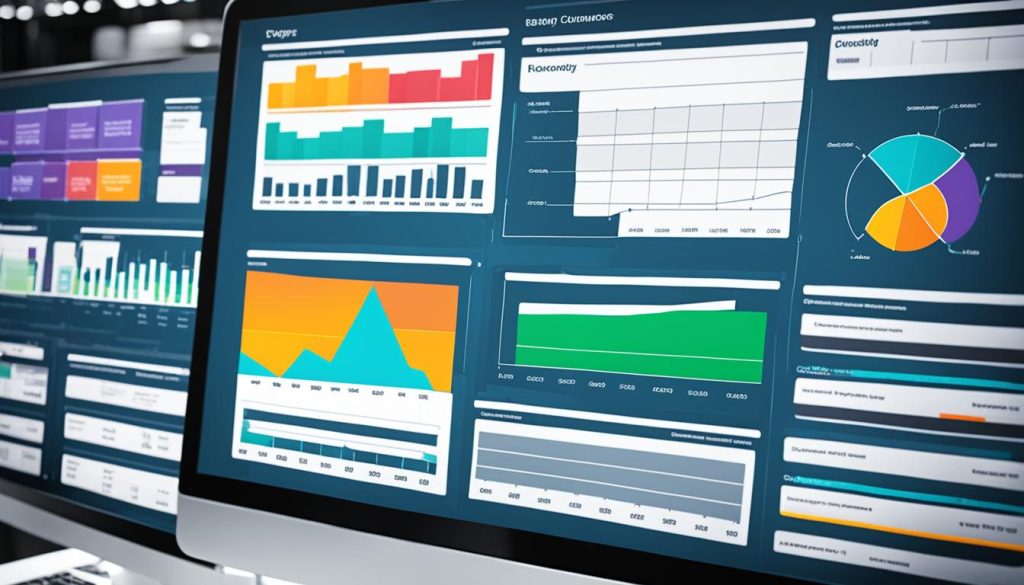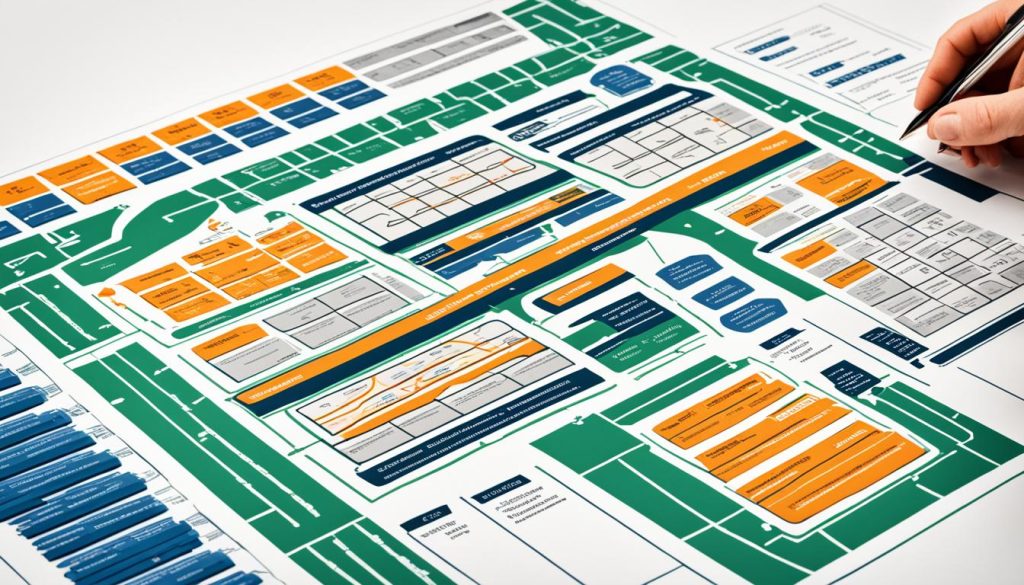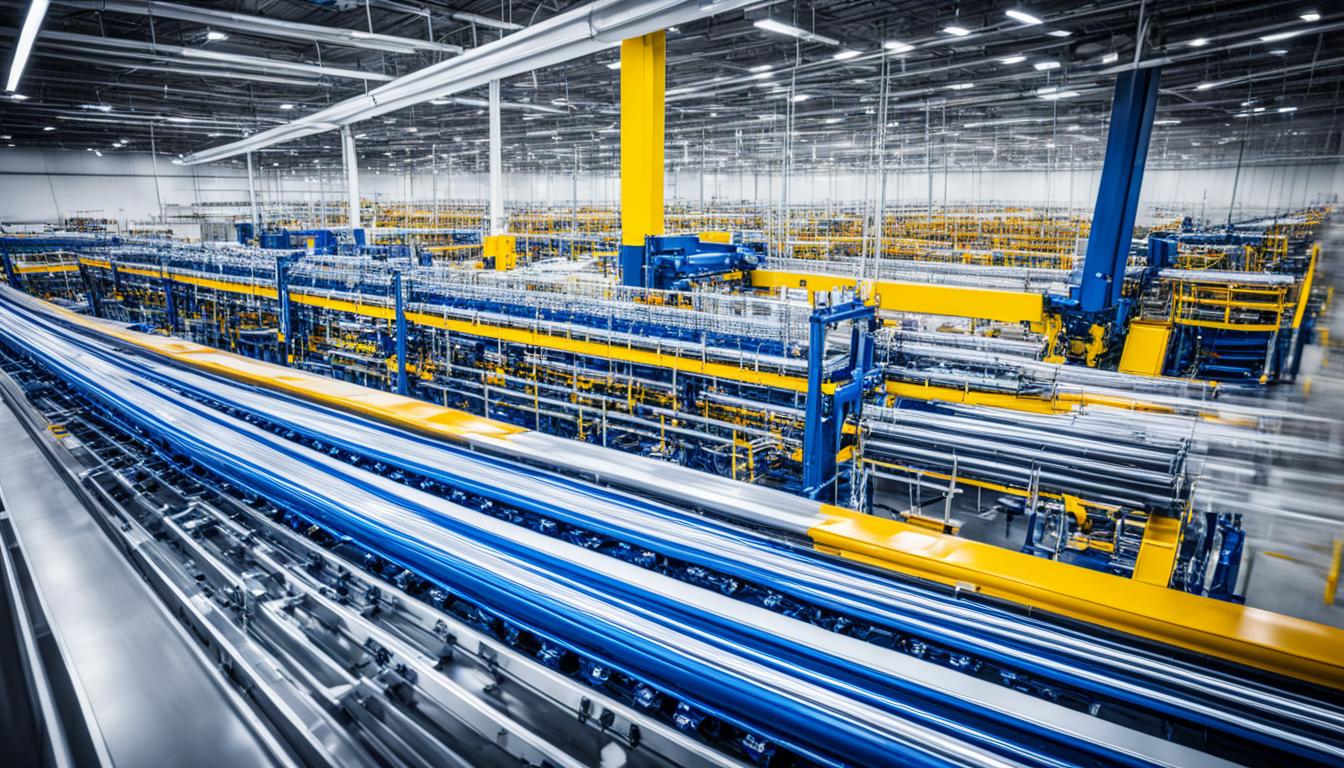Logistics Project Management: Optimize Supply Division
Picture yourself leading a global project. It’s like conducting a huge orchestra that spans across countries and hours. Each detail needs to be perfect, or else the music won’t sound right. This challenge is what logistics project management is all about. It keeps the supply chain of your business moving smoothly.
As industries grow faster, making your supply chain more efficient is critical. It adds toughness and new ideas to companies everywhere. Lowering the costs in logistics stops them from eating up your profits. Take the example of a manufacturing firm. It reduced material shortages by 30% using Any.do Workspace. This shows how important planning is in operations1.
Looking closer at these management strategies, we see big changes. They’re all about sustainability, using new tech, and thinking globally but acting locally2. Using the internet and digital tools helps update the whole process. This makes sure managers can keep up with what the markets need, avoiding risks and delays2.
But saving money remains important. By improving supply chains, some companies have cut delays by up to 30% and saved 15% on costs. Leading in logistics management means guiding a team where every move leads to success. Each success brings us closer to fulfilling our customers’ needs3.
Understanding the Interplay of Project Management and Supply Chain
Combining Supply Chain Management (SCM) with project management boosts project results. It also keeps operations efficient and agile. SCM methods help projects succeed by making processes smoother, guaranteeing quality, and enhancing communication among all involved.
Defining the Role of SCM in Project Success
SCM is key in managing projects because it improves how resources are planned and managed4. This is crucial when project results rely on getting resources on time and within budget, which the Project Management Institute stresses for creating distinct products or services4.
A Closer Look at the Components and Phases of SCM
SCM’s lifecycle includes many steps, from crafting strategies to buying and efficient handling4. The Supply Chain Operations Reference (SCOR) Model splits these steps into Planning, Sourcing, Making, Delivering, Returning, and Enabling5. These elements keep the supply chain strong and quick to respond to what the market needs, affecting project timing and outcomes.
Navigating the Complexities of Supply Chain Networks
Understanding SCM’s complex network, including risk management, is crucial. The DIRECT framework tells project leaders to plan with clear goals and be ready for changes and new stakeholder needs5. Using smart strategies is essential for managing supply chain challenges, especially in unpredictable markets.
SCM tactics in project management reduce risks from supply chain problems. They ensure projects have various suppliers and backup plans. These steps are vital for project success and for staying flexible in changing markets.
Logistics Project Management Tools and Technologies
Logistics is all about using modern tech to improve operations and work more efficiently. With tools like project scheduling software and transportation management systems, management of logistics projects becomes seamless.
Transportation plays a vital part in logistics management. An impressive 90% of logistics pros use transportation management systems. These systems make routes efficient and keep track of shipments in real time6. They help avoid delays and cut costs in moving goods.
For organizing and monitoring projects, 80% of logistics experts turn to software like Asana or Trello. These programs boost teamwork and keep tasks organized6. Such tools are key to handling project timelines and resources effectively.
Warehouse automation technology is changing how companies handle inventory and logistics. It’s used by 85% of logistics pros. These systems keep stock levels just right and make warehouse operations smoother6. Automation means orders are filled correctly, boosting warehouse efficiency.
Procurement management tools are essential in logistics projects. They help project managers pick suppliers, handle orders, and keep an eye on procurement. By doing this, they avoid project delays and stay within budget.
| Technology | Utilization Rate | Benefit |
|---|---|---|
| Transportation Management Systems | 90% | Optimize routes, track shipments |
| Project Management Software | 80% | Enhance collaboration, track tasks |
| Warehouse Management Systems | 85% | Manage inventory, optimize operations |
With these technologies combined, managing logistics projects is more effective. They ensure every part of the supply chain works together to meet goals and deadlines. By adopting these tools, operations run smoother and innovation in logistics project management is promoted.
Strategic Resource Planning for Efficient Project Outcomes
In today’s complex business world, planning resources wisely is a must. It aligns project goals with the company’s aims so projects can finish on time and budget. As projects get more complicated, it’s crucial to use resources well for smooth project results. This part talks about matching resources with project schedules and using inventory software to change how resources are managed.
Matching Resources to Project Goals and Timelines
Resource planning means aligning resources with project needs for success. It involves figuring out what’s needed early and scheduling resources to avoid delays. Since nearly all large projects face problems from bad management and resource issues, being ahead in planning matters a lot. By aligning resources and goals, projects do better, and resources are used fully.
Utilizing Inventory Control Software for Resource Management
Inventory software is key for managing resources today. It helps keep inventory at the perfect level, avoiding too much or too little that can mess up projects and raise costs. This software gives up-to-date inventory info, crucial for smart resource choices. Plus, it helps predict what resources will be needed later, which means better planning and budget control.

The table below highlights the benefits of using inventory control software in resource planning:
| Feature | Benefit |
|---|---|
| Real-time Inventory Tracking | Ensures that resource levels are managed efficiently, reducing instances of overstocking or shortages. |
| Resource Forecasting | Helps predict future resource requirements, allowing for better financial and resource planning7. |
| Detailed Reporting | Provides insights into resource usage and project expenditures, leading to more informed decision-making. |
Procurement Management Techniques for Logistics Projects
Managing procurement well is key to a logistics project’s success. It needs careful planning, smart talking with suppliers, and wise spreading of resources. Using procurement tools helps make these steps better and makes the supply chain flow smoothly.
- Supplier Negotiations: Talking well with trusted suppliers to agree on terms good for both sides is important. This makes sure we always get what we need without losing quality or going over budget.
- Resource Allocation: It’s important to use what we have wisely, including people and materials. This keeps the project on time and within budget.
| Stage | Activities Involved |
|---|---|
| Plan Procurement Management | Defining evaluation criteria, identifying cost methodologies, selecting potential suppliers8. |
| Conduct Procurements | Supplier negotiations, signing contracts, securing resources9. |
| Control Procurements | Monitoring supplier performance, managing contracts, ensuring compliance to terms10. |
| Close Procurements | Finalizing deliverables, closing contracts, conducting final assessments. |
Knowing and using the four main steps of procurement management is critical. This is especially true for big logistics projects that deal with lots of suppliers, complicated deliveries, and detailed tracking of resources810. This planned way lowers risks and makes the supply chain work better.
With top procurement tools, you can make these steps smoother. This leads to more reliable results and keeping projects on time and within budget. Good talks with suppliers and smart use of resources are key to improving a project’s logistics9.
Streamlining Cost Management in Logistics

In the world of business, cost management in logistics is crucial. By using advanced supply chain logistics and cost-saving methods, companies can improve their efficiency. This also helps in cutting down expenses.
Leveraging Supply Chain Logistics for Cost Efficiency
Supply chain logistics are key to staying ahead in the market. By making processes smoother, companies save time and money on transportation and warehousing11. Automation further enhances efficiency by lowering operation costs11. Exploring cost-reducing logistics strategies can offer a good starting point.
Applying Best Practices in Procurement and Cost Reduction
Using best procurement practices helps achieve cost management objectives in logistics. Strategic sourcing and ERP systems reduce costs. They offer real-time data and make inventory management better, preventing over or understocking12. Creating good relationships with suppliers can also lead to discounts and lower shipping costs. Companies like Corrugated Metals Inc. show how this works well for freight forwarding services13.
Modern technologies and strategic supply chain planning significantly lower costs. Addressing cost control challenges with a proactive stance is key to benefitting from cost efficiency.
The Growing Impact of Warehouse Automation Tools
Today, warehouse automation is changing the game in logistics. It makes things run smoother and keeps track of everything better. By using smart systems, companies can make their work faster and without mistakes.
Improving Efficiency with Automated Storage and Retrieval Systems
Automated Storage and Retrieval Systems (ASRS) make warehouses work better and faster. They save space and reduce errors, keeping customers happy. The rise in warehouse automation is impressive, expected to grow more than 10% every year14. Robot shipments will also increase by up to 50% until 203014.
Integrating Automation for Better Warehouse Operations
Warehouse automation tools mix technology with manual work, making warehouses run smoother. Companies spend a lot on these tools, aiming to automate a big part of their operations14. They are trying out new ways to pay for it that could cut costs by 60 to 80%14.
Big e-commerce companies buying Autonomous Mobile Robot (AMR) makers shows they’re serious about automation. They want to build fully automated warehouses, changing the industry14.
Learn how big companies are making these changes by looking at our in-depth report on getting warehouse automation right14.
Companies like Ocado are setting new benchmarks with faster order assembly than ever before. This hints at a bright future for warehouses powered by automation15.
Insights from frontiers in warehouse automation show how these technologies speed up work, improve accuracy, and reduce costs15. Firms like Maersk are already boosting their operations with automation15.
A look at the future of warehouse automation highlights the crucial role of RFID in better inventory management16.
In short, as global logistics evolves, warehouse automation tools are becoming more essential. These tools not only improve efficiency but also set the stage for future success in inventory management.
Ensuring Quality Control and Mitigating Risks
For project management, things like quality and risk management are key. They make sure projects do well and supply chains are strong.
Today, only 21% of companies say their supply networks are strong17. This shows a big need to improve. It’s crucial to work on better risk management and quality control. Doing this helps businesses spot and fix issues early. Their goal is to make their supply chains very tough soon17.
Knowing how to manage supply chain risks helps companies make smart plans. It’s important to check the supply network for weak spots17. Also, learning from past mistakes in quality helps better manage it in the future18.Click here and here to learn more.
“Implementing rigorous quality controls and continuous monitoring of supply chain processes is not optional but a necessity in safeguarding against unforeseen disruptions.”
Using technology is key in improving supply chain management. Around 50% of experts think tech boosts efficiency and openness in supply chains19. The SCM field is expected to grow fast, by 11.2% CAGR until 202719. So, using new technology is a must now, not just in the future.
Quality control gets better with regular checks and audits. These steps make sure supply chains meet quality standards. This improves the outcomes of projects18. Also, good cybersecurity and data management keep information safe and build trust17.
To learn more about SCM strategies, see how a strong SCM framework helps with risk management in logistics. This is key to facing new challenges.
Revolutionizing Logistics Project Management with Transportation Management Systems
Logistics projects are getting more complex. A strong transportation management system (TMS) changes how goods move and stay. These systems make operations smoother and improve control over transportation.
Optimizing Movement of Goods Through Advanced Routing and Scheduling
A TMS like Digital Fractal uses smart algorithms for better routes. This cuts travel time and fuel costs. Companies see lower shipping costs and work more efficiently20.
They also use real-time data to quickly adjust to new market needs and customer wishes21.
Implementing Real-time Tracking for Improved Transparency
Real-time tracking is key in modern TMS tools. It gives everyone clear updates on where shipments are. This builds trust in the supply chain.
Using RFID and mobile scanners, managers get the info they need fast21. This means happier customers and more reliable shipping20.
With a TMS, companies boost their efficiency and make customers happier. Being able to see shipments in real-time and change plans quickly avoids delays.
TMS platforms like Digital Fractal have tools for easier billing and less mistakes20. They help companies plan ahead with data analytics21. So, using a high-tech TMS is crucial for staying ahead in the market.
Conclusion
In logistics project management, success comes from managing your supply chain well. When everything works together, it boosts business and affects global trade22. Skilled managers lead the charge. They navigate through changes and challenges with great skill and leadership2324.
These managers balance communication, technical skills, and problem-solving. This ensures projects finish on time and within budget23. With the help of strong networks and talented teams, companies can make their operations better. They achieve better costs, manage risks well, and use resources smartly2324.
Look at Apple. They show how good project management in supply chains leads to worldwide success and happy customers22. Supply chain optimization is key in logistics management. It helps companies become more efficient and stay ahead in the market. Learning from leaders like Dell and Apple helps others improve too. For those navigating supply chain challenges, insights from Sumeera Sarwar on LinkedIn offer valuable perspectives on this changing field2422.
FAQ
What is Logistics Project Management and its significance in business?
Logistics project management is about planning, doing, and managing the moving and storing of goods. It aims to deliver products efficiently and improve the supply chain. It’s key for meeting customer needs, increasing efficiency, and staying competitive.
How does SCM contribute to Project Management success?
SCM helps project management by making sure materials are there when needed. It optimizes resources and assures quality. SCM keeps projects on track and within budget, leading to success.
What are the key components of Supply Chain Management (SCM)?
SCM’s main parts include buying materials, moving products, storing inventory, distributing goods, and sharing information. This optimizes the supply chain and spots problems early.
Why is it important to manage complex supply chain networks effectively?
Managing complex networks is vital because of their wide reach and variety of partners. It guarantees smooth operations, predictable outcomes, and deals with issues promptly. Advanced software adds to this by giving real-time updates.
Which tools and technologies are vital for Logistics Project Management?
Necessary tools include systems for managing transport and projects, plus warehouse and inventory software. They help in making logistics operations better.
How does strategic resource planning influence project outcomes?
Smart planning makes sure resources match project goals, preventing delays and extra costs. Good inventory software is crucial for this and makes supply chains better.
What methods are utilized in Procurement Management for Logistics Projects?
Procurement management uses careful supplier choice, risk checking, and watching performance. Special tools make these tasks smoother to meet project demands efficiently.
How can companies streamline cost management in Logistics?
To cut costs, companies improve buying, transportation, and inventory management. They also use cost-saving tech. Strategies include smart sourcing, getting discounts, and long-term deals with suppliers.
What role do Warehouse Automation Tools play in Logistics Project Management?
Automation tools boost warehouse work, making it more accurate and faster. This is key for good logistics management today, making warehouses run smoother.
How does quality control and risk management factor into SCM?
Quality control and risk plans are central to SCM. They make sure materials are up to standard and prepare for supply issues. This keeps projects on time and budget.
How do Transportation Management Systems (TMS) revolutionize Logistics Project Management?
TMS change Logistics Project Management by improving how goods are routed and scheduled. This lowers transport costs. TMS’s real-time tracking also makes the supply chain more open and responsive.
Source Links
- https://www.any.do/blog/project-management-for-logistics-and-supply-chain-management/ – Project Management for Logistics and Supply Chain Management
- https://flatworldgs.com/logistics-project-management-best-practices-trends-tips/ – Logistics Project Management: Best Practices, Trends & Tips | Flat World Global Solutions
- https://medium.com/@rohit.jadhav20/optimizing-supply-chain-for-effective-project-management-cb00bae9190d – Optimizing Supply Chain for Effective Project Management
- https://www.vibrantpublishers.com/blogs/operations-project-management-blogs/operations-and-supply-chain-vs-project-management – Operations and Supply Chain vs Project Management
- https://www.bonniebiafore.com/the-relationship-between-project-management-and-supply-chain-management/ – The Relationship Between Project Management and Supply Chain Management
- https://www.johnpipe.co.uk/the-role-of-technology-in-modern-logistics-project-management/ – Logistics Project Management – The Role of Technology
- https://www.eresourcescheduler.com/blog/resource-planning–the-ultimate-guide-for-project-and-resource-management – Resource Planning – The Ultimat Guide for Resource Management
- https://www.projectmanager.com/blog/project-procurement-management-quick-guide – Project Procurement Management: A Quick Guide
- https://opentextbc.ca/projectmanagement/chapter/chapter-13-procurement-management-project-management/ – 13. Procurement Management
- https://pmworldlibrary.net/wp-content/uploads/2023/09/pmwj133-Sep2023-Harake-project-logistics-management-a-literature-review.pdf – Project Logistics Management
- https://www.camcode.com/blog/how-to-reduce-logistics-costs/ – How to Reduce Logistics Costs: 19 Experts Reveal Ways Organizations Can Cut Their Logistics Transportation and Carry Costs – Camcode
- https://www.apu.apus.edu/area-of-study/business-and-management/resources/improving-cost-control-challenges-in-supply-chain-management/ – Improving Cost Control Challenges in Supply Chain Management
- https://www.corrugated-metals.com/blog/6-strategies-to-reduce-logistics-costs/ – Strategies to reduce logistics costs
- https://www.mckinsey.com/capabilities/operations/our-insights/getting-warehouse-automation-right – Getting warehouse automation right
- https://www.scmr.com/article/frontiers-in-warehouse-automation – Frontiers in warehouse automation
- https://www.sdcexec.com/warehousing/automation/article/22871949/a-quiet-revolution-the-future-of-warehouse-automation – A Quiet Revolution: The Future of Warehouse Automation
- https://global.hitachi-solutions.com/blog/supply-chain-risk-management/ – Supply Chain Risk Management: 10 Strategies for Success – Hitachi Solutions
- https://www.linkedin.com/advice/3/what-your-best-practices-mitigating-quality-risks – What are your best practices for mitigating quality risks in projects?
- https://targetintegration.com/risk-management-importance-in-the-logistics-and-supply-chain-management – Role of Risk Management in Logistics & Supply Chain Management
- https://digitalfractal.com/introduction-to-transportation-management-systems-tms-and-how-they-revolutionize-the-industry/ – Introduction to Transportation Management Systems (TMS) and How They Revolutionize the Industry – Digital Fractal Technologies Inc
- https://www.sdcexec.com/sourcing-procurement/project-management-software/article/22861772/how-technology-is-revolutionizing-project-management – How Technology is Revolutionizing Project Management
- https://www.qodenext.com/blog/supply-chain-and-project-management/ – Difference Between Supply Chain And Project Management
- https://advisorycloud.com/blog/how-to-find-project-management-experts-for-a-logistics-company – How to Find Project Management Experts for a Logistics Company
- https://www.linkedin.com/pulse/navigating-challenges-supply-chain-project-management-sumeera-sarwar – Navigating the Challenges of Supply Chain Project Management





